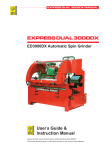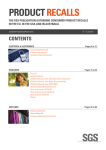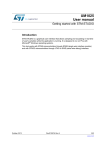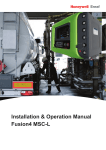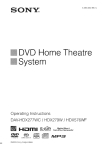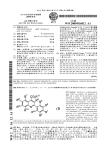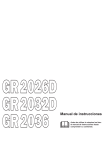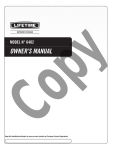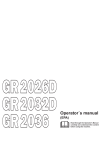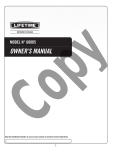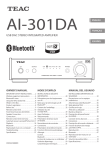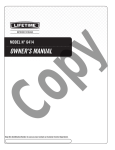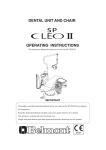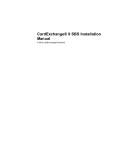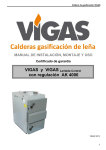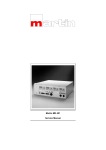Download Technical manual AKS 32 FP
Transcript
Technical manual AKS 32 FP Item code/code article: 170 000 049 A Reference/référence: SAV MANU 018 ed 01 Date/date: 12.1998 Technical manual AKS 32 FP - SAV MANU 018 ed 01 1 SUMMARY GENERAL 2 INTRODUCTION 3 SAFETY PRECAUTIONS 5 SAFETY GUIDE (PRECAUTIONS ON USING THE SYSTEM) 6 DESCRIPTION OF SIGNAL WORDS 7 DESCRIPTION OF WARNING & CAUTION LABEL 8 LISTING OF WARNING AND CAUTION LABELS 9 INSTALLATION - PART A 13 MAINTENANCE - PART B 43 Technical manual AKS 32 FP - SAV MANU 018 ed 01 INTRODUCTION Before using this system, be sure to read this instruction manual carefully. Before using this system, read important warning carefully. For the sake of safety, observe the precautions shown below in repair work. 1- This system is used to process color negative roll film. Do not use it for other purposes. 2- Operate your system properly according to this operation manual for safe and optimum performance. 3- Always keep this operation manual near the system and observe all cautions and instructions as required. 4- Follow the instructions in this operation manual and observe all caution labels. For details, refer to the "Description of Caution Labels". 5- Install the system on a flat and stable surface, and do not expose the system to direct sunlight. 6- The work environment conditions call for room temperature of 15°C - 30°C and relative humidity of 30% 80%. An optional cooling unit is required to maintain the processing performance of the negative processor should room temperature exceed 30°C. 7- The cabinet has ventilation holes to prevent a rise in temperature. Never block or cover the ventilation holes with any objects. 8- Never insert your hand or any object into the ventilation holes of the cabinet ; otherwise, you may suffer eclectric shock. 9- Except when indicaded in this operation manual and user maintenance manual, users are prohibited from serving this system (by disassembling, remodeling, adjusting or using parts not specified). Should you remove the cover not specified, you may be exposed to high voltage and the danger like electric shock and burning yourself. 10 - Turn off the power source before initiating any maintenance indicated in this operation manual or the user maintenance manual. Should the power not be switched off. You may suffer electric shock. 11 - Never remove the attached caution labels. 12 - If this operation manual is missing, contact your dealer. Should caution labels peel off or become stained or otherwise damaged, replace them with new ones. 13 - To purchase an additional operation manual or caution labels, contact your dealer or our sales division as indicated on the back cover. 14 - When the waste solution is disposed of, contact an waste-article collector qualified by the national or local government according to the law requiation. 15 - Machine noise informations for order 3.GSGV,18.01.1981 : the maximum sound pressure level is 70dB (A) or less in accordance with ISO 7779. Technical manual AKS 32 FP - SAV MANU 018 ed 01 3 INTRODUCTION 16 - Before starting any maintenance work described in this manual, be sure to turn off the power completely. A failure to turn off the power may cause electric shocks, injury or damages to the film processor. 17 - The film processor is grounded with the 3-wired power cable, etc... Never disconnect the grounding wire to avoid electrocution. 18 - On completion of repair work, make certain that all removed screws, pads, etc..., are attached in the proper positions. 19 - Do not use any substandard or nonstandard repair parts. 20 - Do not attempt to carry out any repair works not described in this manual. 21 - Never pull the cable to unplug the connector. 22 - After replacing or repair work, connect wire and cables carefully not to bring them into contact with burrs or sharp edges. In particular, do not bring wires and cables into contact with movable parts or driving parts. 4 Technical manual AKS 32 FP - SAV MANU 018 ed 01 SAFETY PRECAUTIONS This machine has been checked in accordance with the laws pertaining to the various product safety regulations before leaving the factory. When serving it, be sure to observe the following precautions. 1- Do not use fuses other than those of the specified ratings. 2- Never modify electrical circuit. 3- Do not use unspecified replacement parts. 4- Confirm that all screws, pads and wiring which were removed for serving have been re-installed in their original position. 5- When disconnecting connectors, do not pull the wiring (particularly AC line wiring and high voltage parts). 6- Do not perform any unspecified modifications. 7- Do not run the power cord where it is likely to stepped on or crushed. 8- Carefully clean off chemical solutions adhering to electrical units. 9- After replacing or repair work, route wiring in such a way that it does not touch burrs or other sharp edges. 10 - Machine noise informations for order 3.GSGV,18.01.1981 : the maximum sound pressure level is 70dB (A) or less in accordance with ISO 7779. IMPORTANT NOTICE Because inexperienced person servicing may causes hazards to people and to the equipment, we, KIS strongly recommends that all servicing is performed only by our trained service engineer. This machine must be disposed of as industrial waste. Be sure the contact any qualified waste-article collector. Technical manual AKS 32 FP - SAV MANU 018 ed 01 5 SAFETY GUIDE (Precautions on using the system) Operation Precaution Label position Remark 1. Handling chemicals Wear safety gloves, protective glasses and masks when handling solutions. If solutions contact your eyes or skin, wash off them with water for more than 15 minutes and get medical treatment. Chemicals may cause skin irritation. W-3 Instruction Section 7 Installation Section 4 2 . Handling the sprocket for switching the power frequency Fingers may be clipped! The power breaker must be switched off before handling the sprocket for swicthing the power frequency. W-4 3 . Handling the chain and sprocket Fingers or hair may be clipped! The power breaker must be switched off before handling the chain for the sprocket. W-2 4 . Handling the drying heater Your fingers may be burnt! When handling the dryer heater, be sure to turn off the power breaker and wait more than 15 minutes before initiating operation. 5 . Replacing the cutter blade Your fingers may be cut! The power breaker must be switched off when changing the cutter blade. 6 . Replacing fuse You may suffer electric shock! The power breaker must be switched off before changing a blown fuse. a Service Section 6 Service Section 6 W-1 W-5 Maintenance Section 2 Instruction Section 18 C - 1 Installation Section 3 L-1 Installation Section 3 7 . Connecting the input power supply cord See installation instructions before connecting to the supply. 8 . Handling the sprocket for switching the power frequency (installation & maintenance) Fingers may be clipped! The power breaker must be switched off before handling the sprocket for switching the power frequency W-4 Section 6 9 . Handling the chain and sprocket (installation & maintenance) Fingers or hair may be clipped! The power breaker must be switched off before handling chain for the sprocket. W-2 Section 6 6 Technical manual AKS 32 FP - SAV MANU 018 ed 01 DESCRIPTION OF SIGNAL WORDS - Signal words indicate the levels of potential danger. - Signal words are categorized into three levels according to the possibility and seriouness of danger. D a n g e r : indicates a situation of immediate danger which may result in serious injury or death, if not avoided. Warning : indicates a situation of potential danger which may result in serious injury or death, if not avoided. C a u t i o n : indicates a situation of potential danger which may result in slight or minor injury. This term is also used for physical damage aside from personal risk and injury. Probability of damage Damage Injury (and physical damage) (High probality) Damage may be caused (Low probality) Death or serious injury (Damage is serious) Danger Warning Medium or slight injury (Damage is slight) Warning or Caution Caution Physical damage only is caused Caution - Example of the signal word. Technical manual AKS 32 FP - SAV MANU 018 ed 01 7 DESCRIPTION OF WARNING & CAUTION LABEL POSITION OF WARNING AND CAUTION LABELS TO BE ATTACHED Note : Attached on the outside Attached on the inside 8 Technical manual AKS 32 FP - SAV MANU 018 ed 01 LISTING OF WARNING AND CAUTION LABELS - Each warning or caution label should correspond to a position where it is attached. - Order labels from the local office or sales division indicated on the back cover of this manual by referring to the part numbers. Position Label Part N° W-1 L43-A6324 W-2 L43-A6327 Technical manual AKS 32 FP - SAV MANU 018 ed 01 9 Position 10 Label Part N° W-3 L43-A7581 W-4 L43-A6326 Technical manual AKS 32 FP - SAV MANU 018 ed 01 Position Label Part N° W-5 L43-A6325 C - 1 L43-A6329 L-1 L43-A6320 Technical manual AKS 32 FP - SAV MANU 018 ed 01 11 12 Technical manual AKS 32 FP - SAV MANU 018 ed 01 PARTA INSTALLATION Technical manual AKS 32 FP - SAV MANU 018 ed 01 13 SUMMARY - PART A 1. ITEMS TO BE CHECHED BEFORE INSTALLATION 1.1. EXTERNAL VIEW 3 15 1.2. SPACE REQUIPMENTS 16 1.3. VENTILATION AND AIR-CONDITIONNING 16 1.4. TRANSPORTING MACHINE INSIDE INSTALLATION BUILDING 17 1.5. INSTALLING ON A SECOND STORY (LEASING A CRANE) 17 1.6. TRANSPORTING MACHINE TO INSTALLATION AREA 17 1.7. DISPODAL OF WASTE SOLUTION 17 2. INSTALLATION 2.1. UNPACKING PRECAUTIONS 18 2.2. UNPACKING PROCEDURE 18 2.3. PACKAGE 19 2.4. INSTALLATION OF PROCESSOR 22 2.5. LEVELING MACHINE 22 2.6. CHEKING DIP SWITCHES ON CPU BOARD 25 2.7. ATTACHING STANDARD ACCESSORIES 25 3. ELECTRICAL REQUIREMENTS AND CONNECTIONS 3.1. POWER CONSUMPTION 26 3.2. CONNETIONS AND RATED CAPACITIES 26 3.3. CONNECTING THE TRANSFORMER ACCORDING TO SUPPLY VOLTAGE 27 3.4. CONNECTING THE POWER SUPPLY UNIT 28 3.5. WIRING PRECAUTIONS 29 3.6. WIRING METHOD 3.6.1. For single-phase, three-wire 3.6.2. For 3-phase, 4-wire Power 30 30 31 3.7. POWER SUPPLY UNIT 32 4. MIXING THE CHEMICALS 4.1. GENERAL INSTRUCTIONS FOR SAFE USE 35 4.2. INSTRUCTIONS FOR MIXING CHEMICALS 36 5. SETTING BASIC REPLENISHMENT AMOUNT 5.1. SETTING BASIC REPLENISHMENT AMOUNT 37 5.2. SETTING PUMP (BELLOWS PUMP) REPLENISHMENT RATE 38 6. FUSES 7. STANDARD ACCESSORIES ACCOMPANYING DOCUMENTS AND OPTIONS 14 7.1. STANDARD ACCESSORIES 40 7.2. ACCOMPANYING DOCUMENTS 42 7.3. OPTIONS 42 Technical manual AKS 32 FP - SAV MANU 018 ed 01 1 ITEMS TO BE CHECKED BEFORE INSTALLATION 1.1 EXTERNAL VIEW Technical manual AKS 32 FP - SAV MANU 018 ed 01 15 2) Installation space (the minimum distance to the wall - unit : mm) NOTE: the space for other equipments (paper processor, etc ...) should be also considered. 1.2 SPACE REQUIPMENTS 1) The machine weight is as follows. Make sure that the floor is solid enough to support the weight. Machine weight Machine weight with solutions 170 kg 250 kg 2) A ceiling is required to be at least 1,7 m high to pull the racks out of the machine. 3) Do not install the machine in direct sunshine. (Make use of blinds or curtains if they are necessary). 4) It is recommended to cover the floor with waterproof material because processing solutions may be spilled on it. 5) Check for any inclination or unevenness of the floor. 1.3 VENTILATION AND AIR-CONDITIONNING 1) Since the film processors discharge hot air for drying, make sure the room is well-ventilated and an air-conditioner is used in summer. 2) A heating system is recommended in winter to warm up the processing solution quickly and provide operators a pleasant environment. 3) The working environment conditions call for room temperature of 18 - 28°C and relative humidity of 30 - 80%. An optional cooling unit is required when the system is continuouly operated for 8 hours or more at the room temperature of 28°C or more. 16 Technical manual AKS 32 FP - SAV MANU 018 ed 01 1.4 TRANSPORTING MACHINE INSIDE INSTALLATION BUILDING When transporting the machine trough the building doors, be sure to measure the actual door dimensions. The corrugated carton case measures 680 mm (W) x 1240 mm (L) x 1490mm (H). If the package proves too large for ordinary doors, unpack the processor before bringing it into the room. 1.5 INSTALLING ON A SECOND STORY (LEASING A CRANE) - Make all the arrangements (crane arriving time & place, payment and who is each work) carefully. - Procure sufficient manpower. Be sure to take the safety measures. - Check the transporting route and prepare the required tools. responsible for 1.6 TRANSPORTING MACHINE TO INSTALLATION AREA Choose the most convenient route to the installation area after thorough investigation of local traffic conditions and the neighborhood. 1.7 DISPOSAL OF WASTE SOLUTION Secure a place to store waste solution for later disposal by authorized agent. Technical manual AKS 32 FP - SAV MANU 018 ed 01 17 2. INSTALLATION 2.1 UNPACKING PRECAUTIONS 1) Although the AKS 32 FP is both shipped in single packages, the packing method differs between products for domestic and overseas markets (see fig. 2-1). 2) Before unpacking, make an investigation thoroughly about the installation place, transporting conditions and unloading place from the pallet. 3) Unpack in a large area other than the installation room. 2.2 UNPACKING PROCEDURE Overseas model 1) Cut the 2 packing bands with knife. (since the bands may bound, care must be taken). 2) Remove the cap (top box). 3) Remove the accessory case and cushioning materials. 4) Pull out the 6 nails holding the case to the pallet. 5) Slip the case up and off. 6) Unload the equipement from the pallet. 7) Check the list of standard accessories & spare parts and attached documents for any missing items. 18 Technical manual AKS 32 FP - SAV MANU 018 ed 01 2.3 PACKAGE Package of AKS 32 FP Fig. 2-1 Package Dimensions : 1240 mm (L) x 680 mm (W) x 1490 mm (H) Weight : 230 kg Technical manual AKS 32 FP - SAV MANU 018 ed 01 19 General Drawings (for overseas model) P a c k a g e Dimensions : 1240 mm (L) x 680 mm (W) x 1490 mm (H) Weight : 230kg NOTE : 1) The code number, machine number, machine type, size and weight should be printed on the particular area of shipping case. 2) The shipping case should be sealed with the black cloth tape, and tightened with polyester bands en 2 places. 3) The package should withstand piling en 3 layers. 20 Technical manual AKS 32 FP - SAV MANU 018 ed 01 Description N° Drawing N° Item 1 Pallet 2 Body 3 Q'ty Dimension L W H Specification 1 1240 680 220 1 1220 660 1340 A A F Corner post 1 3 1200 100 15 Honeycomb Bent in the center 4 Corner post 2 1 1200 100 15 Honeycomb Bent in the center 5 Top cover hold plate 1 1180 810 23 AAF + AAF Protecting top cover 6 Air cap 1 910 650 Air cap For tray 7 Body cover (overseas) 1 1200 630 1300 Vinyl Against dust 8 Band 2 19 Polyester Trade item 9 Fastener 2 19 Polyester Trade item 10 Cap nail 6 11 Polyester bag 1 12 Packing list 1 14 One set of accessories (1) 15 Packing (1) case label Wood & pol yethylene Remark 50L 400 Made by pack Mizutani Trade item 280 For manuals A4-size copy paper Technical manual AKS 32 FP - SAV MANU 018 ed 01 21 2.4 INSTALLATION OF PROCESSOR To install CFP-232T/252TII, a 19mm wrench is required to fix the 4 adjusting bolts and nuts (see fig. 2-2) an addition to standard tools. After preparation of the electrical system (see the chapter "3. Electrical requirements and connections" and the installation guide), bring the machine into the room and install it according to the following steps. 1) Carry the processor to the installation place. Install it at least 30cm aprt from the wall. gsfdg 2) Lift the front (replenisher tank side) of the processor and put the tray under the processor. 2.5 LEVELING MACHINE Rack leveling is required because the processor has a flexible structure (comb frames and panels are separate parts and they are just bolted together). First, check that the machine is level at the upper frames where the rack holders are attached and then reconfirm at the racks. The alignment of racks are very important for smooth film transport. 1) Carry the machine (equiped with caster) to the installation position and turn the leveling bolts until the casters are lifted. 2) Leveling the machine. a - Take off the top cover, and check the alignment of the racks on the upper right frame and upper left frame respectively, and then cheek the level between right and left upper frames. Do not check at the rack holders because they are not aligned (the diameters are differs). A spirit level longer than 300mm is recommended. After pouring solution into the tank, cheek the level by the spirit level again. Note : after the above cheeking, make sure that the cop cover can be opened and closed properly, and the crossover racks and the rack units can be easily removed and set. 22 Technical manual AKS 32 FP - SAV MANU 018 ed 01 b - Set the racks in the tanks, and cheek the alignment of the racks, if the racks are not in alignment, it may cause transporting problems because the short leader touches the side plates of the next rack when crossing the racks. Because the racks have some play (0 ~ 0,2mm) on the rack holders, put them all off to the left side (rack drive side) of the processor. By placing a 15cm metal ruler (with flat surface) against the outer surface of the rack plates, make sure that there is not uneveness more than 0,5mm between the rack and the one two racks away from it. c - If the uneveness is more than 0,5mm, align the racks as shown below. Racks tend to get out of line toward lower side. If position B and/or C is lower, the racks are pushed toward left in the direction from N° 1 to N°8. Raise B and/or C by turning leveling bolts. If position A and/or D is lower, the racks are pushed toward right in the direction from N°1 to N°8. Raise A and/or D by turning leveling bolts. Note : dot not adjust the level by lowering the higher side with leveling bolts. Because the dryer rack side is so heavy that the machine can be supported by the other 3 leveling bolts with the adjusted one is floated, and the machine may be slanted in a long time. I there is no choice, turn the casters with your hand to make certain that they do not touch the floor. Technical manual AKS 32 FP - SAV MANU 018 ed 01 23 d - Check that the racks are easily removed and set. Remove the rack holders and lift the rack 5-10mm up and release it to check that it falls into the racks receiver smoothly. Check each rack from N°1 to N°8. (Be careful to avoid contamination because this is done after the solution is poured into the tank). e - Tighten the double nuts against the welded nuts to lock the leveling bolts. If the double nuts are not tightened enough, the bolts become loose by vibration. f - Request : The machine may slant after installation. Check that the machine is level a few weeks afterward. Ask the customer to contact the service staff when the machine has to be reinstalled in other place. 24 Technical manual AKS 32 FP - SAV MANU 018 ed 01 2.6 CHECKING DIP SWITCHES ON CPU BOARD Before the power is supplied, open the control box cover and check that the DIP switches on the CPU board are set correctly. DIP SWITCH ON/OFF TABLE FUNCTION DS2-1Circulation pump on-demand Set position on delivery ON On-demand control OFF When not used ON 2 Frequency ON 60Hz OFF 50Hz OFF 3 DRY temperature for 120 film ON Set temp. +20°C control OFF Set temp. +10°C control OFF 4 DRY temperature control ON 40°C control OFF When not used OFF 5 Low guard ON 20°C control in cold-district OFF When not used OFF 6 Basic replenishment rate setting ON Basic repl. amount setting OFF Repl. rate in % setting OFF 7 Unused 8 For OFF debugging (set to OFF) OFF DS3-1 Language setting ON 2 Language setting OFF 3 Language setting OFF 4 Language setting OFF Backup battery switch located on the right of DS3 ON * Be sure to set DS2-2 according to the power frequency. 2.7 ATTACHING STANDARD ACCESSORIES 1) Attach a filter to each temperature control tank. 2) Attach the leader receiving set to the outlet of the dryer unit. 3) Attach the films receiving box below the outlet of the dryer unit. Technical manual AKS 32 FP - SAV MANU 018 ed 01 25 3. ELECTRICAL REQUIREMENTS AND CONNECTIONS 3.1 POWER CONSUMPTION 1) Power consumption per input voltage Supply voltage Power consumption 220V 230V 240V 3.13kW 3.40kW 3.70kW 2) Electrical capacities of xarious units Input Description Power consumption (50Hz) Voltage Q'ty Heater H1 240V 350W 1 Heater H2 240V 350W 1 Heater H3 240V 240W 1 H4, H5 240V 1250W 2 Circulation pump PU2 100V 26W 1 Circulation pump PU1.3-8 100V 15W 7 Replenishing RPU1-4 100V 4.5W 4 M 100V 10W 1 Dryer fan FAN2 100V 27W 1 Exhaust fan FAN1 100V 17W 1 Cut solenoid CUTSO 100V 24W 2 Push solenoid PUSHSO DC24V 12.7W 2 Lock solenoid LOCKSO DC24V 8W Drying heater pump Drive motor Cooling fan FAN3 100V 8.5W 3.2 CONNECTIONS AND RATED CAPACITIES L1 AKS 32 FP N 26 Technical manual AKS 32 FP - SAV MANU 018 ed 01 220-240V 20A 1 1 3.3 CONNECTING THE TRANSFORMER ACCORDING TO SUPPLY VOLTAGE The primary voltage of the power supply is set to 230ACV when the CL-KP32TQA2 is delivered from the factory. Should the service voltage be other than AC 230V, change the setting accordingly. Available primary taps include 220, 230 and 240 ACV. 1) Read the voltage across the terminals immediatly to the line side of the circuit breaker on the distribution panel. Check the power frequency on the left (50/60Hz). 2) Open the control box cover. 3) Remove the control box cover and locate the power transformer on the left. Detailed drawing of power transformer terminals For a line viltage other than AC 230V, remove the connected cable attached to the 230V taps (hatched cord), then attached this cable to the appropriate taps. Note : Make sure that the circuit is dead when connecting the cable. Technical manual AKS 32 FP - SAV MANU 018 ed 01 27 3.4 CONNECTING THE POWER SUPPLY UNIT 1) Turn off the breaker on the distribution panel is the system installation room, as well as the processor's breaker switch. 2) Insent the Cabtyre cable from the distribution panel through the power cable bushing (A) shown in the figure below, then connect into the terminal block (B). 3) Connect the grounding wire to PE (C), then connect the power cable to position L and N/L1, L3 and N (Single-phase, two-wire/3-phase, 4-wire) on the terminal block (B). Wiring material (Single-phase) AKS 32 FP Cross-section (SQ = mm²) Type Capacity O 2.5 H05VV-F 25A O 4 H05VV-F 32A AKS 32 FP Cross-section (SQ = mm²) Type Capacity O 1.5 H05VV-F 16A O 2.5 H05VV-F 25A Wiring material (3-phase 4-wire) For processor Wiring sizes (Single-phase, 3-phase 4-wire) 28 Outer diameter (mm) Power cable Bushing 8.5-10.5 SCL-10B 10.5-12.5 SCL-14A 12.5-14.5 SCL-14B Technical manual AKS 32 FP - SAV MANU 018 ed 01 Note : do not fail to lengthen the length of the grounding wire than that of the power cable. 3.5 WIRING PRECAUTIONS 1) Grounding Fault Circuit Interrupter (GFCI) For safety's sake attach a circuit breaker (GFCI) to each feeder line to the distribution panels. 2) Grounding Line Be sure to use an isolated PE wire instead of a neutral PE conductor for grounding. If such a PE wire is not available, use an additional wire. 3) Connection of other equipment When equipment other than the AKS 32 FP are connected to the same distribution panel, be sure to note the following points. - The unbalance factor (load balancing of L1 and L2). - The capacity of yhe main-line breaker. - The need for an earth leakage breaker to protect additional equipment. 4) Leakage current detection sensitivity of each leakage breaker Basically, the 30mA-type earth leakage breaker should be used. Should a highly sensitive breaker be used in the branch circuit, however, use an eath leakage breaker with higher sensitivity. Technical manual AKS 32 FP - SAV MANU 018 ed 01 29 3.6 WIRING METHOD 3.6.1 For single-phase, three-wire Wiring materials 30 CB : Circuit Breaker CFCI : Ground fault circuit interrupter (fault current detecting sensitivity = 30 mA). Technical manual AKS 32 FP - SAV MANU 018 ed 01 3.6.2 For 3-phase, 4-wire Power Wiring materials CB : Circuit breaker CFCI : Ground fault circuit interrupter (fault current detecting sensitivity = 30 mA). Technical manual AKS 32 FP - SAV MANU 018 ed 01 31 3.7 POWER SUPPLY UNIT Specifications 1) The single-phase power supply of 220 to 240 ACV is standard. A three-phase, four-wire system can also be used by simply replacing the power supply unit. 2) The power supply unit should have a function to prevent overcurrent. 3) To stabilize the secondary voltage against input voltage of AC220 V, 230 V or 240 V select appropriate primary tap of the power transformer. 4) The maximum load balancing rate of the three-phase transformer should be 30% or less. Types of Input Voltage 1) Single-phase 220 to 240 ACV. 2) Three-phase, four-wire 220 to 240 ACV Difference in input power supply (240V supply) 32 Three-phase Four-wire L1-N section L2-N section L3-N section 1.2 kW 1.25 kW 1.25 kW Single-phase L-N section 3.7 kW Technical manual AKS 32 FP - SAV MANU 018 ed 01 Load sharing 1) Single-phase system 2) Three-phase, four-wire system Technical manual AKS 32 FP - SAV MANU 018 ed 01 33 Wiring of Power Supply Unit Single-phase, two-wire power supply unit Three-phase, four-wire power supply unit How to replace an optional power supply unit 1) Take off the control box cover. 2) Pull out connector CN1 out. 3) Remove the two screws that secure TB1 in place. 4) Remove the grounding wire from PE. 5) Remove the two screws that secure the breaker unit in place. 6) Follow the above procedures in reverse (i.e, steps 5 to 1) to attach an optional power supply unit. 34 Technical manual AKS 32 FP - SAV MANU 018 ed 01 4. MIXING THE CHEMICALS 4.1 GENERAL INSTRUCTIONS FOR SAFE USE 1) Keep the contact with the chemicals to the minimum. Treat them carefully to avoid spillage. 2) If the chemicals contact your skin, wash off with a lot of running water and then with soap. If the developer is spilt on your skin, the same step should be made. 3) If the chemicals get in your eyes, wash out with lots of running water for about 15 minutes. If the pain remains, seek medical treatment. 4) Be sure to wash hands before eating, after handling the chemicals. Do not take food into chemical handling area. 5) The processing tanks for the machine must be used to keep or carry the chemicals. Do not use other containers, especially for food, to measure or keep the chemicals. 6) If the chemicals is drunk, drink salt water at once to spew it up. Seek medical treatment immediatly. 7) Keep the chemicals in a dark, cool place. Keep out of reach of children because of acid or alkaline components. Technical manual AKS 32 FP - SAV MANU 018 ed 01 35 4.2 INSTRUCTIONS FOR MIXING CHEMICALS 1) Make sure that the drain cock is turned off firmly. 2) Handle the removed racks and crossover racks very carefully. 3) Mix all chemicals carefully according to the solution manual. The contamination-preventive cover must be used when mixing chemicals. (see the list shown below for tank capacity). 4) Use a measuring glass to measure the starter solution. 5) Put back the processing racks, crossover racks, light shield plates and rack retaining plates after mixing chemicals. 36 * Install the processing rack into the processing tank carefully in order to prevent contamination. * The solution level in the filter section of the temp.control tank drops while the circulation pump for processing solution operates. The solution level should reach the line in the filter section of the temp.control tank. Operate the circulation pump and turn it off, and them check the solution level while the pump is not operating. Pour the chemicals into N3-2 and N4-3 tanks whose solution levels go down because their solutions are circulated into the hoses which control their next tanks. TANK DEV BL FIX-1 FIX-2 STB-1 STB-2 STB-3 CAPACITY (L) 16.7 4.4 4.2 4.6 3.2 3.4 3.8 Technical manual AKS 32 FP - SAV MANU 018 ed 01 5. SETTING BASIC REPLENISHMENT AMOUNT 5.1 SETTING BASIC REPLENISHMENT AMOUNT The values below refers to the chemical volumes required* for processing a 135-24 exp. film or a one meter linear of film. 135 film format DEV BL FIX STB mL or 24 exp. film 23.0 5.0 33.0 40.0 mL or m.film 20.9 4.5 30.0 36.4 (basic repl. amount) * : this basics values are adjustable according to type of chemical used and the production of the machine. Turn on DS-6 on the CPU board 1) Enter the basic replenishment setting mode. 2 REPL PRM 2) Select the chemical. 3) If the set value is not correct, change it. 4) Input the new value. (ex. 20.9 mL) 5) Confirm the display and lock it. SET Set basic reple. amount in % 50 DEV basic amount (35.5ml 21.75) xx 50 DEV basic amount (35.5ml 21.75) 15% 50 The cursor appears 2 YES 0 9 DEV basic amount (20.9ml 21.75) 15% 50 DEV basic amount (20.9ml 21.75) 15% 50 6) Now the basic replenishment rate is set. Technical manual AKS 32 FP - SAV MANU 018 ed 01 37 5.2 SETTING PUMP (BELLOWS PUMP) REPLENISHING RATE Measure each chemical (DEV, BL, FIX, STB) tank's bellows pump replenishing rate with the measuring glass. Input the measured rate to fix the bellows pump replenishing rate for processing 1-meter-long film. * Turn off DS2-6 on the CPU board 1) Enter the pump replenishing rate setting mode. 2 REPL PRM x5 2) Select the pump. Set pump replenishing rate DEV pumping rate 90 mL/min 50 3) Operate the selected pump for 60 seconds (The buzzer sounds when the operation is finished). * Measure the bellows pump replenishing amount with the measuring glass. Do not take the first replenishing rate into account because the pump contains air. Measure 3 times and calculate the average (98 mL). 4) Press SET key to display the cursor. 5) Input the average value (98mL) 6) Confirm the display and lock it. DEV replenishing 60.0 sec YES 50 The time is counted down on the display DEV pumping rate _90 mL/min SET 0 YES 9 8 DEV Pumping rate 98 mL/min 50 50 DEV Pumping rate 98 mL/min 50 When the setting is finished, the cursor disappears 7) Now the pump replenishing rate is set. Pour the measured solution back into the tank 38 Technical manual AKS 32 FP - SAV MANU 018 ed 01 6. FUSES N° RATING TYPE SIZE LOAD F1 AC250V 3.15A NORMAL Ø5.2x20mm DEV HEATER F2 AC250V 3.15A NORMAL Ø5.2x20mm FIX-2, STB-3 HEATER F3 AC250V T3.15A TIMELAG Ø5.2x20mm DEV-2 CIRCULATION PUMP F4 AC250V T3.15A TIMELAG Ø5.2x20mm DEV-1, BL, FIX-1, FIX-2, CIRCUL. PUMP F5 AC250V T3.15A TIMELAG Ø5.2x20mm STB-1, STB-2, STB-3 CIRCUL. PUMP F6 AC250V T3.15A TIMELAG Ø5.2x20mm DEV, BL, FIX, STB REPLENISHING PUMP F7 AC250V T2A TIMELAG Ø5.2x20mm DRYER FAN F8 AC250V T3.15A TIMELAG Ø5.2x20mm DRIVE MOTOR, CUT SOLENOID (L), (R) Technical manual AKS 32 FP - SAV MANU 018 ed 01 39 7. STANDARD ACCESSORIES ACCOMPANYING DOCUMENTS AND OPTIONS 7.1 STANDARDS ACCESSORIES Case N° 1 * * * * N° 1 2 3 4 5 6 7 8 9 10 11 12 13 14 15 16 17 18 19 20 21 22 23 Part Name Q'ty Film receiving box Short leader receiving box Chemical filter set Crank handle Tray for body Film splicer Short leader Splicing tape Control strip magazine (126) Bat Turnguide rack washing bat Splash guard Drain hose Tape cutter tray Wash bottle Tool set (with tool bag) Spare fuse set (see the following list) Spare parts (see the following list) 120 film magazine 110 film attachment 126 film attachment Ball Cut 1 unit 1 set 7 sets 1 pc. 1 pc. 1 set 15 shts 1 pc. 1 pc. 1 pc. 1 pc. 1 pc. 1 pc. 1 set 1 pc. 1 set 1 set 1set 1 pc. 2 pcs. 2 pcs. 1set 1 pc. Spare parts details Ring Ø3 blue Ring Ø4 yellow Ring Ø5 gray Ring Ø6 white Drive pocket Pin 43-A0483 43-25022-2 43-05838-2 43-85464-1 43-05076-1 Z72022006 3 3 10 3 2 2 pcs. pcs. pcs. pcs. pcs. pcs. Spare fuse set ZLI314010 ZLI314003 ZLI313004 1 pc. 1 pc. 1 pc. ZLI216315 ZLI218315 ZLI218002 1 pc. 1 pc. 1 pc. Tool set Tool gag Phillips screw driver Flat screw driver Double-end sparner (13X10) Double-end sparner (8X7) Hexagon wrench 2.0 Hexagon wrench 3.0 Hexagon wrench driver 2.0 Tool (terminal) 210-120J 40 Technical manual AKS 32 FP - SAV MANU 018 ed 01 1 1 1 1 1 1 1 1 1 pc. pc. pc. pc. pc. pc. pc. pc. pc. * Attached to the machine body Technical manual AKS 32 FP - SAV MANU 018 ed 01 41 7.2 ACCOMPANYING DOCUMENTS N° Name Q'ty 1 Packing list 1 pc. 2 Manual 1 set 7.3 OPTIONS N° 42 1 110 film magazine 2 120 film magazine 3 126 film magazine 4 Cleaning unit 5 Cooling fan unit 6 Emergency dark bag 7 3-phase, 4-wire power source unit Technical manual AKS 32 FP - SAV MANU 018 ed 01 PARTB MAINTENANCE Technical manual AKS 32 FP - SAV MANU 018 ed 01 43 SUMMARY - PART B 1. DESCRIPTION OF PARTS 1.1. ARRANGEMENT AND FUNCTION OF ELECTRICAL PARTS 1.1.1. Power supply control section 1.1.2. Interior of set box 1.1.3. Right side view 1.1.4. Left side view 1.1.5. Interior of dryer unit (back side view) 3 46 46 48 49 50 51 2. DESCRIPTION OF PRINT BOARD AND CHECK 2.1. CPU PRINT BOARD 2.2.1. Test points (CPU print board) 2.1.2. LED 2.1.3. Volume 52 52 52 53 2.2. SSR PRINT BOARD 2.2.1. Table of each loard 54 54 3. ADJUSTMENT OF CPU PRINT BOARD 3.1. ADJUSTING THE CPU PRINT BOARD 55 3.2. ADJUSTING TEMPERATURE 3.2.1. Standard voltage 3.2.2. Sensor amplifier 55 55 55 3.3. ADJUSTMENT OF VOLTAGE FOR FILM DETECTING 3.3.1. Setting standard voltage 3.3.2. Check after adjusting 56 56 56 3.4. PRINT BOARD FIGURE & CIRCUIT DIAGRAM 3.4.1. CPU Print board 3.4.2. SSR Print board 57 57 59 4. TROUBLE SHOOTING 4.1. TEMPERATURE CONTROL 4.1.1. The temperature does not rise 4.1.2. The dryer temperature does not rise 4.1.3. The temperature does not go down 4.1.4. The dryer temperature does not rise 61 61 62 63 64 4.2. CIRCULATION PUMP DOES NOT OPERATE 66 4.3. REPLENISHER PUMP DOES NOT OPERATE 68 4.4. DRIVE MOTOR DOES NOT OPERATE 70 4.5. DRYER FAN DOES NOT OPERATE 72 4.6. EXHAUST FAN DOES NOT OPERATE 74 4.7. LOCK SOLENOID DOES NOT OPERATE 76 4.8. PUSH SOLENOID DOES NOT OPERATE 79 4.9. FILM CUT SOLENOID DOES NOT OPERATE 82 5. WHERE TO CHECK THE MECHANICALS 5.1. PROCESSING RACK 85 5.2. DRYER RACK 87 6. MAINTENANCE 44 6.1. DAILY INSPECTION 89 6.2. WEEKLY 6.2.1. 6.2.2. 6.2.3. 6.2.4. 6.2.5. 6.2.6. 6.2.7. 89 89 89 89 89 90 91 92 INSPECTION Checking and cleaning of dryer air filter Checking patrone holder Checking rack unit functioning Cleaning rack unit Checking rack unit operation Inspection and cleaning of crossover rack and STB-3 rack unit Cleaning and changing chemical filter 6.3. MONTHLY INSPECTION A 6.3.1. Cleaning processing tank 6.3.2. Tension adjustment and oiling of drive chain 6.3.3. Checking replenishing pump and circulation pump 6.3.4. Checking and oiling of the movable parts (chain) 6.3.5. Changing chemical filter 6.3.6. Checking processing temperature 6.3.7. Cleaning the inside of the machine 93 93 93 94 94 94 94 94 6.4. MONTHLY INSPECTION B 6.4.1. Cleaning loading unit drive roller 94 94 6.5. SIX-MONTH INSPECTION 6.5.1. Checking the damage of rubber socket and elbow 6.5.2. Checking and cleaning of the electric components 95 95 95 Technical manual AKS 32 FP - SAV MANU 018 ed 01 6.5.3. Checking the wear of bearing 6.5.4. Checking and cleaning of processing tank 6.5.5. Checking the leakage of replenisher tanks and replenisher pumps and their cleaning 6.5.6. Checking temperature control heater 6.5.7. Measuring the pump replenishing rate 95 95 95 95 95 6.6. YEARLY INSPECTION 6.6.1. Cleaning tank 6.6.2. Cleaning dryer rack 6.6.3. Changing dryer air filter 96 96 96 96 6.7. FUSES 97 Technical manual AKS 32 FP - SAV MANU 018 ed 01 45 1 DESCRIPTION OF PARTS 1.1 ARRANGEMENT AND FUNCTION OF ELECTRICAL PARTS 1.1.1 46 Power supply control section Technical manual AKS 32 FP - SAV MANU 018 ed 01 NAME CONTENTS CONTROL PANEL Keyboard PCB, switches, (Operation, Drive) CPU PCB CPU PCB SSR PCB Circulation pump, Replenisher pump cut solenoid Drive motor, Drive PCB for dryer fan RE Power source for CPU PCB (+DC5V) DS Rectifier (DC+24V) C1 Smoothing condenser (DC+24V) NF Noise filter (AC200V) TB1 Connecting terminal (for input supply) TB2 Connecting terminal (for chemical heater) CN1 Connecting terminal (for input supply) CTB Repeating TF Transformer SSR21, 22 SSR for dryer heater CP-1 Circuit protect for dryer heater CP-2 Circuit protect for dryer heater CP-3 Circuit protect for 5V DC line and exhaut fan CP-4 Circuit protect for 24V DC line NBF Main terminal breaker Technical manual AKS 32 FP - SAV MANU 018 ed 01 47 1.1.2 Interior of set box NAME 48 CONTENTS Cover switch (Micro switch) Open/Close detection of set box cover Left & Right solenoid Film cut solenoid Reader-Sensor Detects short leader Lock-Solenoid Lock for set box cover Cut-Sensor For cut solenoid Push-Sensor For push solenoid Film-Sensor (Projector PCB) For film detection Film-Sensor (PT PCB) For film detection Technical manual AKS 32 FP - SAV MANU 018 ed 01 1.1.3 Right side view DEV Heater 240V 350W FIX2 Heater 240V 350W STB3 Heater 240V 240W DRYER Heater 240V 1250Wx2 Technical manual AKS 32 FP - SAV MANU 018 ed 01 49 1.1.4 50 Left side view Technical manual AKS 32 FP - SAV MANU 018 ed 01 1.1.5 Interior of dryer unit (back side view) Technical manual AKS 32 FP - SAV MANU 018 ed 01 51 2. DESCRIPTION OF PRINT BOARD AND CHECK 2.1 CPU PRINT BOARD The CPU print board contains micro computers and controls the machine. The temperature is also controlled by the CPU board. 2.1.1 2.1.2 Test points (CPU print board) CPU P. BOARD CONTENTS TP 5 +5V Supply Voltage DC 5V +0,1 TP 4 5V GND between TP5 and TP4 0 LED LED N° 52 CHECK POINTS CONTENTS LED ON LD 1 110 Film left side When film is defected LD 2 135 Film left side When film is defected LD 3 120 Film left side When film is defected LD 4 120 Film right side When film is defected LD 5 135 Film right side When film is defected LD 6 110 Film right side When film is defected LD 7 Unused LD 8 CPU RUN Technical manual AKS 32 FP - SAV MANU 018 ed 01 When CPU operates properly 2.1.3 Volume VR CONTENTS ADJUSTMENT 1 LCD Brightness The brightness of indicator 2 DEV Temp. control offset 3 FIX2 Temp. control offset Make the display show accurate reading 4 STB3 Temp. control offset of the actual temperature 5 DRY Temp. control offset 6 Unused 7 Temp control analog standard voltage 4.096V+0.001V between TP1-TP4 8 L/R 135 film detecting comparator standard voltage 3.00V+0.05V between TP2-TP4 9 L/R 135 film detecting comparator standard voltage 2.5V+0.05V between TP3-TP4 Technical manual AKS 32 FP - SAV MANU 018 ed 01 53 2.2 SSR PRINT BOARD SSR print board controls signals sent from CPU at the adequate voltage to the load of each signal. 2.2.1 Table of each loard LOAD LED N° SSR N° FUSE N° DEV HEATER LD1 SSR1 FIX2 HEATER LD2 SSR2 STB3 HEATER LD3 SSR3 DEV CIRCULATION PUMP LD4 SSR4 COOLING FAN (OPTION) LD5 SSR5 DEV CIRCULATION PUMP BL, FIX1, 2 CIRCULATION PUMP LD6 SSR6 F4 STB1, 2, 3 CIRCULATION PUMP LD7 SSR7 F5 DEV REPLENISHER PUMP LD9 SSR9 BL REPLENISHER PUMP LD10 SSR10 FIX REPLENISHER PUMP LD11 SSR11 STB REPLENISHER PUMP LD12 SSR12 DRY FAN LD13 SSR13 DRIVE MOTOR LD14 SSR14 CUT SOLENOID (LEFT) LD15 SSR15 CUT SOLENOID (RIGHT) LD16 SSR16 PUSH SOLENOID (LEFT) (SET BOX) LD17 TR1 PUSH SOLENOID (RIGHT) (SET BOX) LD18 TR2 PUSH SOLENOID (LEFT) (SET BOX) LD19 TR3 DRY HEATER LD21 SSR21 SSR22 F1 F2 F3 F6 F7 F8 Technical manual AKS 32 FP - SAV MANU 018 ed 01 D2W 203LD AC200V D2W 203LD AC100V D2W 202LD AC100V D2W 203LD AC100V D2W 2032D AC100V D2W 203LD AC100V D2W 203LD AC100V D2W 202LD AC100V CP-4 (not included in PCB) CP-1 CP-2 (not included in PCB) 54 REMARK 2SD633 DC24V S5C-215L 3. ADJUSTMENT OF CPU PRINT BOARD 3.1 ADJUSTING THE CPU PRINT BOARD Apply voltage testor between check pin TP5-TP4 (GND) on the CPU print board and adjust the voltage 5V +0.1/-0 by turning the volume on 5V switching regulator. 3.2 ADJUSTING TEMPERATURE There are two steps: adjustment of the standard voltage of A/D converter and bias adjustment of sensor amplifier. 3.2.1 Standard voltage Adjust the voltage 4.096V +0.001V between TP1-TP4 check pin with VR7. 3.2.2 Sensor amplifier Operate the machine and adjust the temperature by turning the following volume until the displayed temperature is in accordance with the temperature measured in the tank. (see figure of CPU print board) DEV VR2 FIX2 VR3 STB3 VR4 DRYER VR5 Note : Actual temperature should be measured near the thermistor to be measured. Take the filter out of the tank when temperature is actually measured. Technical manual AKS 32 FP - SAV MANU 018 ed 01 55 3.3 ADJUSTMENT OF VOLTAGE FOR FILM DETECTING Adjust in case the film is not detected properly. 3.3.1 Setting standard voltage Connect the tester's minus (GND) to the check pin TP4 (GND) and the tester's plus to each check pin from TP2 throught TP3 (see the table below). Regulate voltage to the specified value by turning the corresponding volume of each pin before inserting film. 3.3.2 CHECK PIN N° SPECIFIED V VR N° 110 L TP3 2.55V + 0.05V VR9 135 L TP2 3.00V + 0.05V VR8 120 L TP3 2.55V + 0.05V VR9 110 R TP3 2.55V + 0.05V VR9 135 R TP2 3.00V + 0.05V VR8 120 R TP3 2.55V + 0.05V VR9 Check after adjusting LD4-9 When or blink as (Make should be OFF when there is no film being processed. each sized film is transported throught the detector at the inlet each LED should be ON or OFF the following table shows. sure that film spliced to the short leader properly). LED N° SENSOR NO FILM FILM IN PROCESS 110 135/126 120 LD1 110 L X O O/O O LD2 135 L X X /O O LD3 120 L X X X/X O LD6 110 R X O O/O O LD5 135 R X X /O O LD4 120 R X X X/X O : BLINK X: OFF O: ON 56 SENSOR Technical manual AKS 32 FP - SAV MANU 018 ed 01 3.4 PRINT BOARD FIGURE & CIRCUIT DIAGRAM 3.4.1 CPU Print board Technical manual AKS 32 FP - SAV MANU 018 ed 01 57 CPU BOARD CIRCUIT DIAGRAM 58 Technical manual AKS 32 FP - SAV MANU 018 ed 01 3.4.2 SSR Print board Technical manual AKS 32 FP - SAV MANU 018 ed 01 59 SSR BOARD CIRCUIT DIAGRAM 60 Technical manual AKS 32 FP - SAV MANU 018 ed 01 4. TROUBLE SHOOTING 4.1 TEMPERATURE CONTROL 4.1.1 The temperature does not rise The temp. does not rise YES NO Check that the LED on SSR-PCB is turned on. DEV heater: F1 FIX2 heater: F2 STB3 heater: F3 YES YES Check the fuses are OK Check that the display NO Change the temp. shows the accurate read sensor confirm ing of the actual temp. the connection NO DEV heater: F1 FIX2 heater: F2 STB3 heater: F3 YES Check that the voltage is AC200V on the terminal board (TB2) DEV heater: between S1-T1 FIX2 heater: between S1-T2 STB3 heater: between S1-T3 YES Check the resistance of each heater after cutting the power supply and disconnecting the heater. DEV heater: 155~175 Ω FIX2 heater: 155~175 Ω STB3 heater: 225~250 Ω YES NO Confirm the Change connection of each heater. the heater Check that the voltage is less than DC0.7V between the connector (J6) on SSR-PCB and the check pin TP4 (GND) on CPU-PCB. NO DEV heater: between J6-1A-TP4 FIX2 heater: between J6-1B-TP4 STB3 heater: between J6-2A-TP4 YES Confirm the connection of J6 on CPU-PCB and J6 on SSR-PCB. Change the SSR-PCB NO Check that the voltage is AC200V on the terminal board (TB2) NO Change the CPU-PCB DEV heater: between R1-S1 FIX2 heater: between R2-S1 STB3 heater: between R3-S1 YES Check the continuity of each bimetal after cutting the the power supply and disconnecting bimetal on TB2. DEV: between R1-T1 (Bi1) FIX2: between R2-T2 (Bi2) STB3: between R3-T3 (Bi3) YES NO Confirm the connection of each bimetal. Change the bimetal Check that the voltage is AC200V between the connector NO (J4) on SSR-PCB and TB2. Check that the voltage is NO Confirm the connector (J3) on SSR-PCB or the AC200V between the connector power supply connector (CN1). (J3) on SSR-PCB and TB2. DEV heater: between J4-1-S1 FIX2 heater: between J4-2-S1 STB3 heater: between J4-3-S1 DEV heater: between J3-1-S1 FIX2 heater: between J3-2-S1 STB3 heater: between J3-3-S1 YES Confirm the connection between the (J4) on SSR-PCB and TB2. NO DEV heater: between J6-1A-TP4 FIX2 heater: between J6-1B-TP4 STB3 heater: between J6-2A-TP4 YES Change the fuse. Check that the voltage is less than DC0.7V between the connector (J6) and the check pin TP4 (GND) on CPU-PCB. YES Change the SSR-PCB. Technical manual AKS 32 FP - SAV MANU 018 ed 01 61 4.1.2 The dryer temperature does not rise The temp. does not rise YES NO Check that the LED on SSR-PCB is turned on. DRY heater: LD21 Check that the display shows the accurate reading of the actual temp. NO Change the temp. sensor confirm the connection YES YES Check the circuit protector are OK NO Check that the voltage is less than DC0.7V between the connector (J6) on SSR-PCB and the check pin TP4 (GND) on CPU-PCB. NO DRY1 heater: between J6-11A-TP4 DRY2 heater: between J6-11B-TP4 DRY1 heater: CP-1 DRY2 heater: CP-2 Check that the voltage is less than DC0.7V between the connector (J6) and the check pin TP4 (GND) on CPU-PCB. DRY1 heater: between J6-11A-TP4 DRY2 heater: between J6-11B-TP4 YES YES YES Check that the voltage is AC200V on the dryer terminal board (TB3) DRY1 heater: between R4-S2 DRY2 heater: between R5-S3 YES Check the resistance of each heater after cutting the power supply and disconnecting the heater. Change the circuit protector. Confirm the connection of each heater. Change the SSR-PCB Check that the voltage is AC200V on the terminal board (TB2) NO Check that the voltage is AC200V between TB2 and the SSR (the output side). YES YES Confirm the connection between them. NO NO Check the continuity of each bimetal after cutting the the power supply and disconnecting bimetal on TB2. Check that the voltage is AC200V between TB2 and the SSR (the input side). DRY1 heater: between S2-SSR21 DRY2 heater: between S3-SSR22 YES NO Change the bimetal NO YES Check that the SSR input voltage is DC5V. Confirm the connector of the power supply connector (CN1). SSR21: between + SSR22: between + YES Change the SSR. 62 Change the CPU-PCB DRY1 heater: between S2-SSR21 DRY2 heater: between S3-SSR22 DRY1 heater: between R4-S2 DRY2 heater: between R5-S2 Confirm the connection between TB2 and TB3. Change the heater Confirm the connection of (J6) on CPU-PCB and (J6) on SSR-PCB. NO DRY1 heater: 40~50 Ω DRY2 heater: 40~50 Ω YES NO Technical manual AKS 32 FP - SAV MANU 018 ed 01 NO Confirm the connection between the connector (J9) on SSR-PCB and the SSR. 4.1.3 The temperature does not go down (When there is nothing wrong with the liquid surface and circulation pumps). The temp. does not rise YES Check that the LED on SSR-PCB is turned off. NO DEV heater: LED1 FIX2 heater: LED2 STB3 heater: LED3 Check that the display shows the accurate reading of the actual temp. Check that the voltage (DC4~5V) NO is measured between the connector (J6) on SSR-PCB and the check pin TP4(GND) on CPU-PCB. NO DEV heater: between J6-1A-TP4 FIX2 heater: between J6-1B-TP4 STB3 heater: between J6-2A-TP4 DEV heater: between S1-T1 FIX2 heater: between S1-T2 STB3 heater: between S1-T3 YES Cooling unit (option) is required. Change the temp. sensor confirm the connection YES YES Check that the power is shut off between the following terminals on the TB2 NO YES Change the SSR-PCB Check that the voltage (DC4~5V) NO is measured between the connector (J6) and the check pin TP4 (GND) on CPU-PCB. DEV heater: between J6-1A-TP4 FIX2 heater: between J6-1B-TP4 STB3 heater: between J6-2A-TP4 YES Confirm the connection of (J6) on CPU-PCB and (J6) on SSR-PCB. Change the CPU-PCB Technical manual AKS 32 FP - SAV MANU 018 ed 01 63 4.1.4 The dryer temperature does not rise (When there is nothing wrong with the liquid surface and circulation pumps). The temp. does not rise YES Check that the LED on SSR-PCB is turned off. NO Check that the display shows the accurate reading of the actual temp. NO Change the temp. sensor confirm the connection DRY heater: LED21 YES YES Check that the power is shut off between the following terminals on the TB2 NO DRY1 heater: between R4-S2 DRY2 heater: between R5-S3 Check that the voltage (DC4~5V) NO is measured between the connector (J6) on SSR-PCB and the check pin TP4(GND) on CPU-PCB. DRY1 heater: between J6-11A-TP4 DRY2 heater: between J6-11B-TP4 YES YES Confirm the connection between the (J4) on SSR and TB2. Change the SSR Change the SSR-PCB Check that the voltage (DC4~5V) NO is measured between the connector (J6) and the check pin TP4 (GND) on CPU-PCB. DRY1 heater: between J6-11A-TP4 DRY2 heater: between J6-11B-TP4 YES Confirm the connection of (J6) on CPU-PCB and (J6) on SSR-PCB. 64 Technical manual AKS 32 FP - SAV MANU 018 ed 01 Change the CPU-PCB HEATER WIRING DIAGRAM Technical manual AKS 32 FP - SAV MANU 018 ed 01 65 4.2 CIRCULATION PUMP DOES NOT OPERATE Note: there is no wiring problem when they work in test mode The pump does not operate. (When the liquid surface is normal). YES Check that each LED on SSR-PCB is turned on. DEV1 DEV2 BL FIX1, 2 STB1, 2, 3 NO : LD4 : LD6 : LD6 : LD6 : LD7 Check that the voltage is less than DC0.7V between the connector (J6) on SSR-PCB and the check pin TP4(GND) on CPU-PCB. DEV1 DEV2 BL FIX1, 2 STB1, 2, 3 NO : between J6-2B-TP4 : between J6-3B-TP4 : between J6-3B-TP4 : between J6-3B-TP4 : between J6-4A-TP4 YES YES Check that the voltage is AC100V on the terminal board of SSR-PCB. DEV1 DEV2 BL FIX1, 2 STB1, 2, 3 NO DEV1 DEV2 BL FIX1, 2 STB1, 2, 3 : between 2-3 : between 2-5 : between 2-5 : between 2-5 : between 2-6 Check that the fuses on SSR-PCB are OK. YES Check the connection between the terminal board and each pump. DEV1 DEV2 BL FIX1, 2 STB1, 2, 3 YES Change the pump Check that the voltage is less than DC0.7V between the connector (J6) on SSR-PCB and the check pin TP4(GND) on CPU-PCB. Change the SSR-PCB NO Confirm the connection : F3 : F4 : F4 : F4 : F5 Change the fuse. NO YES 66 Technical manual AKS 32 FP - SAV MANU 018 ed 01 Change the CPU-PCB YES Check that the connector (J2) on SSR-PCB is OK. Change the SSR-PCB : between J6-2B-TP4 : between J6-3B-TP4 : between J6-3B-TP4 : between J6-3B-TP4 : between J6-4A-TP4 NO YES Confirm the connection of the connector NO Confirm the connection between (J6) on CPU-PCB and (J6) on SSR-PCB. CIRCULATION PUMP WIRING DIAGRAM Technical manual AKS 32 FP - SAV MANU 018 ed 01 67 4.3 REPLENISHER PUMP DOES NOT OPERATE Note: there is no wiring problem when they work in test mode The replenisher pump does not operate. When the liquid surface, either repl. or effluent tank, is normal). YES Check that each LED on SSR-PCB is turned on. DEV BL FIX STB NO Check that the voltage is less than DC0.7V between the connector (J6) on SSR-PCB and the check pin TP4(GND) on CPU-PCB. DEV BL FIX STB : LD9 : LD10 : LD11 : LD12 NO : between J6-5A-TP4 : between J6-5B-TP4 : between J6-6A-TP4 : between J6-6B-TP4 YES YES Check that the voltage is AC100V on the terminal board of SSR-PCB. DEV BL FIX STB Check that the voltage is less than DC5V between the connector (J6) and the check pin TP4(GND) on CPU-PCB. Change the SSR-PCB NO DEV BL FIX STB : between 2-8 : between 2-9 : between 2-10 : between 2-11 Check that the fuses (F6) on SSR-PCB are OK. YES Check the connection between the terminal board and each pump. : between J6-5A-TP4 : between J6-5B-TP4 : between J6-6A-TP4 : between J6-6B-TP4 NO Change the CPU-PCB YES Change the pump Change the fuse. NO Confirm the connection YES YES Check that the connector (J2) on SSR-PCB is OK. NO YES Change the SSR-PCB 68 Technical manual AKS 32 FP - SAV MANU 018 ed 01 Confirm the connection NO Confirm the connection between (J6) on CPU-PCB and (J6) on SSR-PCB. REPLENISHER PUMP WIRING DIAGRAM Technical manual AKS 32 FP - SAV MANU 018 ed 01 69 4.4 DRIVE MOTOR DOES NOT OPERATE Note: there is no wiring problem when they work in test mode The drive motor does not operate. YES Check that the LED (LD14) on SSR-PCB is turned on. Check that the voltage is less than DC0.7V between the connector (J6-7B) on SSR-PCB and the check pin TP4 (GND) on CPU_PCB. NO YES YES Check that the voltage is AC100V on the terminal board of SSR-PCB. Check that the fuses (F8) on SSR-PCB are OK. NO Between 13-2 YES Change the SSR-PCB. NO Change the fuse YES Check that the voltage is AC100V on the terminal board of SSR-PCB. Check that the enterlock SW of the top cover is OK. NO Between 14-2 NO Check the connection of the connector (J2) on SSR-PCB. Check that the voltage is less than DC0.7V between the connector (J6-7B) and the check pin TP4 (GND) on CPU_PCB. NO YES YES Check that the voltage is AC100V on the dryer unit terminal board. Change the interlock SW Confirm the connection between the interlock SW and the terminal board of SSR-PCB. YES Check the connection between the terminal board and the drive motor. NO YES Confirm the connection between (J6) on CPU-PCB and (J6) on SSRPCB. NO Between 13-2 NO YES Change the drive motor and the condenser. Confirm the connection Confirm the connection between each terminal of SSR board and the corresponding terminal of dryer-unit. 70 NO Technical manual AKS 32 FP - SAV MANU 018 ed 01 Change the SSR-PCB. Confirm the connection of the connector Change the CPU-PCB. DRIVE MOTOR WIRING DIAGRAM Technical manual AKS 32 FP - SAV MANU 018 ed 01 71 4.5 DRYER FAN DOES NOT OPERATE Note: there is no wiring problem when they work in test mode The dryer fan does not operate. YES Check that the LED (LD13) on SSR-PCB is turned on. Check that the voltage is less than DC0.7V between the connector NO (J6-7A) on SSR-PCB and the check pin TP4 (GND) on CPU_PCB. NO YES YES Check that the fuses (F7) on SSR-PCB are OK. NO Change the SSR-PCB. Change the fuse YES Check that the voltage is AC100V on the terminal board of SSR-PCB. NO Check the connection of the connector (J2) on SSR-PCB. NO YES Between 12-2 Change the SSR-PCB. YES Check that the voltage NO is AC100V on the dryer unit terminal board (TB4). Confirm the connection of connector Check that the voltage is less than DC0.7V between the connector (J6-7A) and the check pin TP4 (GND) on CPU_PCB. NO YES Confirm the connection between (J6) on CPU-PCB and (J6) on SSRPCB. Between 12-2 Change the CPU-PCB. YES Check the connection between the terminal board and the dryer fan. NO YES Change the dryer fan. Confirm the connection Confirm the connection between each terminal of SSR board and the corresponding terminal of dryer-unit. 72 Technical manual AKS 32 FP - SAV MANU 018 ed 01 DRYER FAN WIRING DIAGRAM Technical manual AKS 32 FP - SAV MANU 018 ed 01 73 4.6 EXHAUST FAN DOES NOT OPERATE Note: there is no wiring problem when they work in test mode The dryer fan does not operate. YES Check that the voltage is AC100V on the terminal board of SSR-PCB. NO NO Change the circuit protector. YES Between 1-2 Check the connection of the power supply connector (CN1). YES Check the connection between the terminal board and the exhaust fan. NO YES Change the exhaust fan. Confirm the connection 74 Check that the circuit protector (CP-3) is OK. Technical manual AKS 32 FP - SAV MANU 018 ed 01 YES Turn on the main breaker. NO Confirm the connection of the connector. EXHAUST FAN WIRING DIAGRAM Technical manual AKS 32 FP - SAV MANU 018 ed 01 75 4.7 LOCK SOLENOID DOES NOT OPERATE Note: there is no wiring problem when they work in test mode . Turn on the drive switch. . Ready for processing message appears. . Close the set box cover. Check the microswitch for detecting open/close condition of the set box cover (in the input test mode). The leader or film is detected. The lock solenoid does not operate. YES Check that the voltage is less than DC0.7V between the connector pin (J6-10A) on SSR-PCB and the check pin TP4 (GND) on CPU-PCB. Check that the LED (LD19) on SSR-PCB is turned on. YES Check that the voltage is DC24V between the 1-2 pins of the connector (CN5) in the set box. NO Check that the voltage is DC24V between the 3A and 3B of the connector (CN4) in the set box. YES Check the connection between the connector (CN5) and the lock solenoid. YES Change the lock solenoid. NO NO Confirm the connection between (J7) on SSR-PCB and (CN4) in the set box. Check that the voltage is less than DC0.7V between the connector pin (J6-10A) and the check pin TP4 (GND) on CPU-PCB. Confirm the connection between (J6) on CPU-PCB and (J6) on SSR-PCB. Confirm the connection between CN4 and CN5. Check that the voltage is DC24V between 5-6 pins of the connector (J7) on SSR-PCB. NO YES YES YES Confirm the connection NO See the section "How to ensure the operation of set box cover switch". Change the CPU-PCB NO Check that the adequate voltage is measured between 1-2 pins of the connector (J1) on SSR-PCB. NO YES Change the SSR-PCB Check that the circuit protector (CP4) is OK. NO Change the circuit protector YES Confirm the connection of the connector (J1) on SSR-PCB. 76 Technical manual AKS 32 FP - SAV MANU 018 ed 01 NO * How to ensure the operation of the set box cover switch. Check that the set box cover switch operates correctly in the input test mode. NO Cover closed .....Shows 1 Cover opened ....Shows 0 YES OK Short-circuit between 3-4 pins of the connector (CN5) in the set box and check that the correct sign is displayed. NO Short-circuit. .....Shows 1 Open-circuit . ....Shows 0 YES Check the connection between the connector (CN5) and the cover switch. NO YES Short-circuit between 17A-17B pins of the connector (J2) on CPU-PCB and check that the correct sign is displayed. NO Short-circuit. .....Shows 1 Open-circuit . ....Shows 0 Change the cover switch. YES Confirm the connection. Check the connection between CN2 and CN5 in the set box Short-circuit between 17A-17B pins of the connector (J2) on CPU-PCB and check that the correct sign is displayed. NO Short-circuit. .....Shows 1 Open-circuit . ....Shows 0 YES Check the connection between (J2) on SSR-PCB and CN2 in the set box. Change the CPU-PCB. Technical manual AKS 32 FP - SAV MANU 018 ed 01 77 LOCK SOLENOID WIRING DIAGRAM 78 Technical manual AKS 32 FP - SAV MANU 018 ed 01 4.8 PUSH SOLENOID DOES NOT OPERATE Note: there is no wiring problem when they work in test mode . Turn on the drive switch. . Ready for processing message appears. . Close the set box cover. Check that the leader sensor and the push sensor operate correctly in the input test mode. The leader or film is detected. The push solenoid does not operate. NO See the section "How to ensure the operation of set box cover switch". YES Check that the LED on SSR-PCB is turned on. Check that the voltage is less than DC0.7V between the connector (J6) on SSR-PCB and the check pin TP4 (GND) on CPU-PCB. NO NO Push solenoid (L) : between 9A-TP4 Push solenoid (R) : between 9B-TP4 Push solenoid (L) : LD17 Push solenoid (R) : LD18 Change the SSR-PCB YES Check that the voltage is DC24V at the connector CN4 in the set box. NO Push solenoid (L) : between 1A-1B Push solenoid (R) : between 2B-2B Check that the voltage is less than DC0.7V between the connector (J6) and the check pin TP4 (GND) on CPU-PCB. NO Push solenoid (L) : between 9A-TP4 Push solenoid (R) : between 9B-TP4 YES YES Check that the voltage is DC24V at the connector (J7) on SSR-PCB. Confirm the connection between (J6) on CPU-PCB and (J6) on SSR-PCB. Change the CPU-PCB Push solenoid (L) : between 1-2 Push solenoid (R) : between 3-4 YES Confirm the connection between (J7) on SSR-PCB and CN4 in the set box. Check the connection between the connector (CN5) and the lock solenoid. YES Change the lock solenoid. Confirm the connection NO Check that the voltage is DC24V between 1-2 pins of the connector (J1) on SSR-PCB. NO YES Change the SSR-PCB Check that the circuit protector (CP4) is OK. NO Change the circuit protector YES Confirm the connection of the connector (J1) on SSR-PCB. Technical manual AKS 32 FP - SAV MANU 018 ed 01 79 * How to ensure the operation of leader sensor and push sensor. Check that the leader sensor and the push sensor operate correctly in the input test mode. Leader sensor Push sensor NO detected ......... shows 1 not detected ... shows 0 detected ......... shows 1 not detected ... shows 0 YES Check that the voltage is DC5V at of the connector pin (CN2) in the set box. OK NO Leader sensor: between 6A-6B Push sensor (L): between 8A-8B Push sensor (R): between 10A-10B YES Disconnect the connector (CN2) in the set box and check in the power circuit that the correct sign is displayed. Leader sensor between 7A-7B short-circuit 0 open-circuit 1 Push sensor (L) 9A-9B Push sensor (R) NO Check that the voltage is DC5V at of the connector pin (J2) on CPU-PCB. Leader sensor: between 6A-6B Push sensor (L): between 8A-8B Push sensor (R): between 10A-10B short-circuit 0 open-circuit 1 10A-10B short-circuit 0 open-circuit 1 YES YES Check that the correct sign is displayed. For the following pins of the connector (J2) on CPU-PCB. Leader sensor between 7A-7B short-circuit 0 open-circuit 1 Push sensor (L) 9A-9B Push sensor (R) short-circuit 0 open-circuit 1 10A-10B short-circuit 0 open-circuit 1 YES Check the connection between the connector (CN2) and the cover switch. NO Confirm the connection between (J2) on CPU-PCB and (CN2) in the set box. YES Change the sensor. Confirm the connection. 80 Technical manual AKS 32 FP - SAV MANU 018 ed 01 Change the CPU-PCB. NO PUSH SOLENOID WIRING DIAGRAM Technical manual AKS 32 FP - SAV MANU 018 ed 01 81 4.9 FILM CUT SOLENOID DOES NOT OPERATE Note: there is no wiring problem when they work in test mode The push solenoid does not operate. YES Check that the LED on SSR-PCB is turned on. Check that the cut sensor operate correctly in the input test mode. NO YES Cut solenoid (L) : LD15 Cut solenoid (R) : LD16 Check that the voltage is less than DC0.7V between the connector pin (J6) on SSR-PCB and the check pin TP4 (GND) on CPU-PCB. YES Check that the fuses (F8) on SSR-PCB is OK. NO See the section "How to ensure the operation of cut sensor". NO Cut solenoid (L) : between 8A-TP4 Cut solenoid (R) : between 8B-TP4 NO Check that the voltage is less than DC0.7V between the connector (J6) and the check pin TP4 (GND) on CPU-PCB. Change the SSR-PCB Change the fuse. YES Check that the voltage is AC100V at the connector CN3 in the set box. Cut solenoid (L) : between 8A-TP4 Cut solenoid (R) : between 8B-TP4 NO YES Cut solenoid (L) : between 1-2 Cut solenoid (R) : between 3-5 Confirm the connection between (J6) on CPU-PCB and (J6) on SSR-PCB. YES Check that the voltage is AC100V at the connector (J5) on SSR-PCB. NO Cut solenoid (L) : between 1-2 Cut solenoid (R) : between 3-5 YES Check the connection between the connector CN3 and the cut solenoid. Confirm the connection between (J5) on SSR-PCB and CN3 in the set box. NO YES Change the cut solenoid. Confirm the connection 82 Technical manual AKS 32 FP - SAV MANU 018 ed 01 Check the connection of the connector (J2) on SSR-PCB. YES Change the cut solenoid. Confirm the connection NO Change the CPU-PCB NO * How to ensure the operation of cut sensor. Check that the correct sign is displayed for the cut sensor operation. (in the input test mode). NO detected ......... shows 1 not detected ... shows 0 detected ......... shows 1 not detected ... shows 0 Cut sensor Cut sensor YES Check that the voltage is DC5V at of the connector pin (CN2) in the set box. OK NO Cut sensor (L): between 12A-12B Cut sensor (R): between 14A-14B YES Check that the correct sign is displayed for the following pins of the connector (CN2) in the set box. NO Check that the voltage is DC5V at of the connector pin (J2) on CPU-PCB. between Cut sensor (L) Cut sensor (R) NO Cut sensor (L): between 12A-12B 13A-13B short-circuit 0 open-circuit 1 15A-15B short-circuit 0 open-circuit 1 Cut sensor (R): between 14A-14B YES YES Check that the correct sign is displayed. between the following pins of the connector (J2) on CPU-PCB. Change the CPU-PCB. between Cut sensor (L) 13A-13B short-circuit 0 open-circuit 1 Cut sensor (R) 15A-15B short-circuit 0 open-circuit 1 YES Check the connection between the connector CN2 and each sensor. NO Confirm the connection between (J2) on CPU-PCB and (CN2) in the set box. YES Change the sensor. Confirm the connection. Technical manual AKS 32 FP - SAV MANU 018 ed 01 83 CUT SOLENOID WIRING DIAGRAM 84 Technical manual AKS 32 FP - SAV MANU 018 ed 01 5. WHERE TO CHECK THE MECHANICALS 5.1 PROCESSING RACK 1) Assembling diagram of gears and sprocket in each processing rack. Matching mark Sprocket 15T Center gear 15T Rib of the ridge side Rib of the ridge side Gear 25T Precautions for gear setting (see above figure). u Sprocket 15T (with matching mark) * Check the matching mark position. Matching mark u Gear 25T For the gear 25T, set the pin so that a rib at the ridge side is made on the matching mark line. Rib of the ridge side Technical manual AKS 32 FP - SAV MANU 018 ed 01 85 u Center gear 15T For the center gear 15T, also set the pin so that a rib at the ridge side is made on the matching mark line. Rib of the ridge side 2) Precaution for gear cover mounting Check the gear cover finger position (see above figure). Film running direction Gear cover finger 86 Technical manual AKS 32 FP - SAV MANU 018 ed 01 5.2 DRYER RACK 1) Dryer rack diagram Idle gear 25T Film running direction Outlet roller set Idle gear 25T Drive roller set Technical manual AKS 32 FP - SAV MANU 018 ed 01 87 2) Assembling diagram of gears and sprocket in dryer rack. Sprocket 15T Center gear 15T Gear 25T Rib of the ridge side Matching mark Gear 25T Rib of the ridge side Center gear 15T Rib at the ridge side Rib at the ridge side Set the pin into the place so that the ridge-side ribs of the gear 25T and the center gear 15T is aligned on the matching mark of the sprocket 15T. 88 Technical manual AKS 32 FP - SAV MANU 018 ed 01 6. MAINTENANCE The regular maintenance is necessary to keep the machine in good condition. It is important for the purpose of preventive troubles. 6.1 DAILY INSPECTION Follow the instructions in chapter 7 PRE-OPERATION AND POST-OPERATION INSPECTIONS. 6.2 WEEKLY INSPECTION 6.2.1 Checking and cleaning of dryer air filter Open the cover of the temperature control filter tank and take the air filter out of the dryer unit on the right side. Wash it with water and attach it after drying it completely. 6.2.2 Checking patrone holder Open the film set box and push the patrone holder with your hand to check it moves smoothly. 6.2.3 Checking rack unit functioning Pull up the rack unit and turn the sprocket to check it rotates smoothly (see 6.2.5). 6.2.4 Cleaning rack unit Detach the STB-3 rack unit and wash the sponge squeeze rollers with water (see 6.2.6). Technical manual AKS 32 FP - SAV MANU 018 ed 01 89 6.2.5 Checking rack unit operation CAUTION Be sure to turn off the power before checking the rack unit. 1) Turn off the power 2) Open the set box cover. 3) Remove the rack stopper. - Loosen the screw (a) and remove the rack holder (b). 4) Detach the crossover rack unit. - Hold the knob (a) and pull up the crossover rack unit (b). 5) Check the rack unit operation. - Lift the rack unit (a) a little. Turn the driving sprocket (b) by hand to check that it rotates smoothly. - - 90 Technical manual AKS 32 FP - SAV MANU 018 ed 01 POINTS If the driving sprocket does not rotate smoothly, check adhesion of liquid crystals. If the crystals adhere too much, draw out the rack unit and clean it. When moving the rack, care must be taken to avoid contamination by pattering the liquid. 6.2.6 Inspection and cleaning of crossover rack and STB-3 rack unit. CAUTION Be sure to turn off the power before checking the roller. 1) Turn off the power 2) Open the set box cover. 3) Remove the rack stopper. 4) Detach the crossover rack unit. - Hold the knob (a) and move the rack unit inward to detach it. 5) Check the roller. - Turn the roller (b) by hand to check that it rotates smoothly. 6) Detach the STB-3 rack. - Check for crystal adhesion, and gear damage. 7) Clean the squeeze sponge roller. - Wash the sponge roller (a) gently with water. - Check the sponge roller surface. - POINTS If the squeeze roller surface is hardened or cracked, the roller cannot squeeze liquid properly. Contact the service engineer for help. Technical manual AKS 32 FP - SAV MANU 018 ed 01 91 6.2.7 Cleaning and changing chemical filter Check the chemical filter in the temperature control filter tank. If it is dirty enough, clean or change it. The clogged chemical filter causes bad air circulation and excessive temperature which result in uneveness of development, a short life of pumps or unexpected accidents. Renew the chemical filter regularly because the alian substance in the chemical can easily stick to the film. POINTS The renewal frequency is as follows. They are displayed in the pre-operation and post-operation inspection mode. CLEANING REPLACEMENT Every week Every month BL Every 2 weeks Every 2 months FIX-1 Every 2 weeks Every 2 months FIX-2 Every 2 weeks Every 2 months STB-1 Every 2 weeks Every 2 months STB-2 Every 2 weeks Every 2 months STB-3 Every 2 weeks Every 2 months DEV 92 Technical manual AKS 32 FP - SAV MANU 018 ed 01 6.3 MONTHLY INSPECTION A 6.3.1 Cleaning processing tank Take out each processing rack unit wash off crystalized substance sticked to the rollers, gears or usual solution level areas with a brush and warm water (30°C-40°C). It it is hard to remove them, make use of a neutral detergent. Clean the rack unit regularly because too much dirt or crystalized substances cause the scratch or contaminess of the film. 6.3.2 Tension adjustment and oiling of drive chain. Open the front cover and the side covers of the dryer unit, push the place shown in the figure to check the tension of the chain. It it is too loose or too tight, adjust it. (compare the result with the specified value). 1) Push the center of the transmit chain of the motor with your finger and measure the bend (A). (A) should be 5-10mm. Move the drive motor fixing board up and down to adjust the tension. 2) Check the position of the tightener of the rack drive chain and adjust the tension with (C)'S position so that the left chain runs parallel to the right one. Technical manual AKS 32 FP - SAV MANU 018 ed 01 93 6.3.3 Checking replenishing pump and circulation pump. 6.3.4 Checking and oiling of the movable parts (chain) 6.3.5 Changing chemical filter The frequency of changing is displayed at pre-operation and post-operation inspections. 6.3.6 Checking processing temperature Measure the solution temperature in the processing tank with a thermometer and compare the result with the temperature you set. 6.3.7 Cleaning the inside of the machine Because a lot of electric components are used in the machine, the inside of the machine must be kept clean. Us a lower brush to blow off the dust or any foreign substance everyweek. 6.4 MONTHLY INSPECTION B 6.4.1 Cleaning loading unit drive roller The drive rollers need to be cleaned regularly because film cannot be transported smoothly by the dirty rollers. Use the specific cleaning leader and take the following steps. 1) Moisten the front and back of the fabric of the leader. Absorb excess water with dry cloth. 2) Open the loading box cover and insert the leader fabric into the center of the right (or left) lane (135 film passage). 3) The rollers are pressed together and the cleaning leader is pulled into them by pushing the push solenoid. 4) Clean the rollers by moving the leader fabric forward and backward. Care should be taken to avoid having the entire cleaning leader taken into the rollers. 5) Clean the rollers (rub them with the cleaning leader) for 5-10 minutes. 6) Release the solenoid and rollers, and pull the leader out. 7) Now the right (or left) lane is cleaned. When you clean the other lane, use the clean part of the leader by keeping the used part cut of the rollers. The cleaning steps 2) - 6) need to be repeated. 94 Technical manual AKS 32 FP - SAV MANU 018 ed 01 POINTS 1) If the entire cleaning leader is taken into the rollers, release the push solenoid. 2) Do not move the patrone holder during cleaning because the cutter might operate. 3) Do not clean the both lane together. 4) Turn on the drive switch after cleaning and wait for 5-10 minutes to start operation until the rollers are dried completely. 5) The frequency of cleaning depends on the environment or how many rolls of film are processed. Generally monthly cleaning is recommended. 6) Wash the used cleaning leader with soap. 6.5 SIX-MONTH INSPECTION 6.5.1 Checking the damage of rubber socket and elbow 6.5.2 Checking and cleaning of the electric components Blow off dust with the air spray. 6.5.3 Checking the wear of bearing 6.5.4 Checking and cleaning of processing tank Ckeck the leakage from the circulation/agitating pumps or the drain cocks. 6.5.5 Checking the leakage of replenisher tanks and replenisher pumps and their cleaning 6.5.6 Checking temperature control heater 6.5.7 Measuring the pump replenishing rate Technical manual AKS 32 FP - SAV MANU 018 ed 01 95 6.6 YEARLY INSPECTION 6.6.1 Cleaning tank 1) Draw out the rack unit. - 2) Discharge the processing solution. 3) Clean the tank. Clean the rack unit according to the 6.2.6) cleaning rack unit (page 49) Pour solution into plastic bag (5L or 10L). - Clean each tank with water (dispose of the water). - Fill the tank with fresh water. - Make iddle running for approx. 10 minutes. - Discharge and dispose of the water. - Return the solution kept in plastic bag into the tank. - 6.6.2 POINTS Clean the tanks with water only. Never use any detergent If the solution is contaminated, renew it. Cleaning dryer rack Take out the dryer rack and wipe it with soft cloth. 6.6.3 96 Changing dryer air filter Technical manual AKS 32 FP - SAV MANU 018 ed 01 6.7 FUSES N° RATING TYPE SIZE LOAD F1 AC250V 3.15A NORMAL Ø5.2x20mm DEV HEATER F2 AC250V 3.15A NORMAL Ø5.2x20mm FIX-2, STB-3 HEATER F3 AC250V T3.15A TIMELAG Ø5.2x20mm DEV-2 CIRCULATION PUMP F4 AC250V T3.15A TIMELAG Ø5.2x20mm DEV-1, BL, FIX-1, FIX-2, CIRCUL. PUMP F5 AC250V T3.15A TIMELAG Ø5.2x20mm STB-1, STB-2, STB-3 CIRCUL. PUMP F6 AC250V T3.15A TIMELAG Ø5.2x20mm DEV, BL, FIX, STB REPLENISHING PUMP F7 AC250V T2A TIMELAG Ø5.2x20mm DRYER FAN F8 AC250V T3.15A TIMELAG Ø5.2x20mm DRIVE MOTOR, CUT SOLENOID (L), (R) Technical manual AKS 32 FP - SAV MANU 018 ed 01 97 This document is not binding. The manufacturer reserves the right to modify his machines and this manual without prior notice. Document non contractuel. Le constructeur se réserve le droit de modifier ses machines et le présent document sans préavis. 98 Technical manual AKS 32 FP - SAV MANU 018 ed 01


































































































